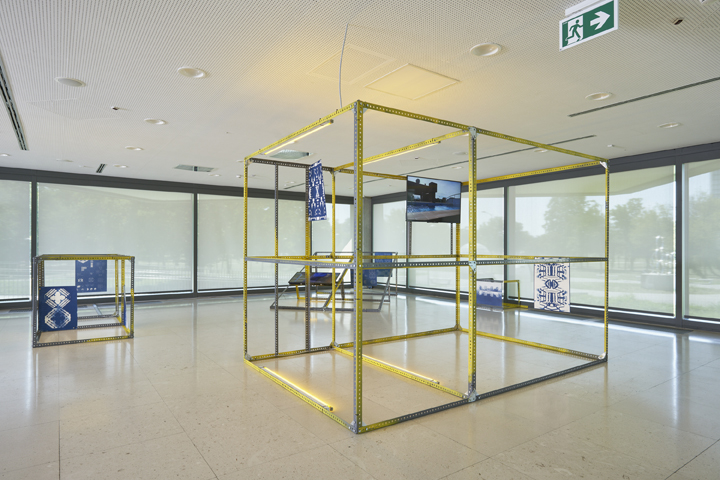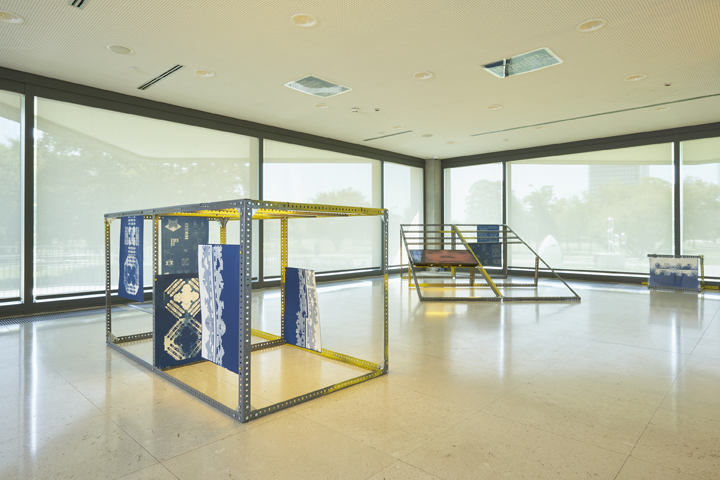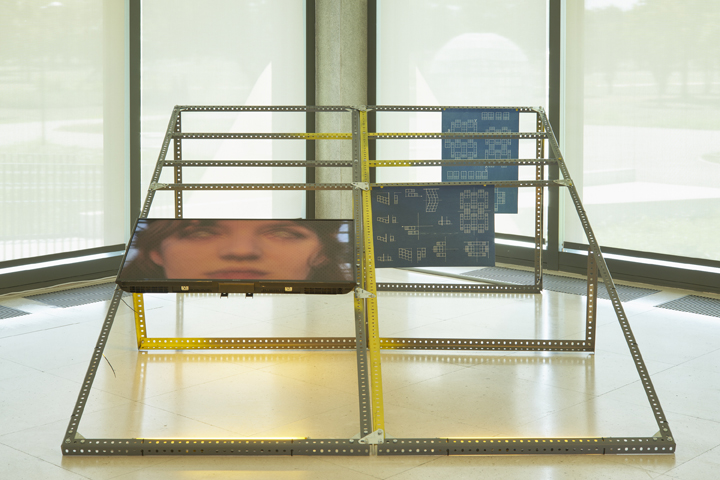PLASTIC, MARBLE AND HELICOPTERS
2- channel video installation, polyurethane foam and vinyl sofa (4 pieces) Produced at the Jan Van Eyck Academie (Maastricht, NL), 2019 - 2020 With the support of Poltronova (IT), Stichting Stokroos (NL)
Exhibition view at: ITINERARIOS XVII at Centro Botín, Santander, ES (2021)
Photos: Belén de Benito




Plastic, Marble and Helicopters is the culmination of a year-long investigation into Global Tools, a pioneering pedagogical project initiated in 1972 by several architectural studios of the "Italian Radical Movement", led by Ettore Sottsass. Global Tools advocated the "re-foundation of manual labour" and the use of "poor techniques" and "simple technology", invoking the body as the ultimate form of architecture, a place of hidden political and creative potential.
Plastic, Marble and Helicopters recovers some of the lessons learned from this group to repropose them as events or encoun- ters. Anna Moreno's interest lies in the clash between the Marxist-anarchist quality of the group's experiments and their work with high-end companies such as Poltronova, Olivetti, or Gufram. Ettore Sottsass was then the artistic director of Poltronova, a furniture design company, today a research centre that still produces some of the iconic designs of Global Tools members. With Poltronova's support, Moreno designed and produced a four-piece modular sofa, which he later used as a prop for a perfor- mance at Florence's Space Electronic nightclub during the 50th anniversary of its opening. The Florentine nightclub, designed by studio 9999, was the underground hub where Global Tools conducted several of its seminal experiments.
Global Tools' forays into the Florentine countryside, their encounters and unorthodox methods were again present in the way Moreno, along with Elettra Fiumi and the rest of the team, lived and worked together and rehearsed for 4 days at Le Argille, a villa in Chianti belonging to the Fiumi family. It also echoes the glorification of the rural exercised by that group of architects during the 1970s, pre-eminently masculine, white and bourgeois.
TALONE, TESTA, COSTOLA
Series of 10 lamps. Steel, papier-maché, polyestyrene foam, acryclic paint Produced at the Jan Van Eyck Academie (Maastricht, NL), 2020 With the support of Poltronova (IT), Stichting Stokroos (NL)





BILLENNIUM
Video installation, Mecalux structure, cyanotype series
Overview Effect, MOCAB, Belgrade, SE, (2021)
Curated by Eric Zoran and Blanca de la Torre
Photos: Nikola Radić Lucati



BILLENNIUM explores how certain 1970s utopian architectural projects for communal living could be re-signified in the light of a post-apocalyptic, quasi-future reality governed by an economy based on the social structure of beehives. The project was commissioned in 2018 by the Joan Miró Foundation in Barcelona for the exhibition Beehave, curated by Martina Millá, on the ecological emergency of the collapse of bee colonies. Billennium was part of a series of interventions around the city, and was installed at the Colegio de Arquitectos de Cataluña (COAC).
This video installation is based on the modular architecture developed by Spanish architect Ricardo Bofill's Taller de Arquitec- tura during the 1970s, in particular the 1975 building Walden 7 in the outskirts of Barcelona, and borrows from the dystopian literature of science fiction author J.G. Ballard to create a grim backdrop: In his 1962 short story, also titled Billennium, Ballard describes claustrophobia and paralysis in an overpopulated world that has become post-ideological, focused solely on the ever-diminishing distribution of living space between individuals. This installation imagines a post-apocalyptic future based on Ballard's scenario in which honey, like today's gold or oil, would function as the main exchange value, and space (both living and agricultural) is distributed in vertical and modular dwellings.
BILLENNIUM takes the symbol of the bee as a floating signifier (used indistinctly by capitalism and communism to glorify the figure of the worker) to situate itself on the discontinuous line that separates utopia from dystopia, not only in architecture but also in the grand narratives that humans project towards ecology and the future. This gesture of balance is repeated through- out the installation, supported by Mecalux structures based on studies of the primary cell of Walden 7. Likewise, the series of cyanotypes is a reinterpretation of original drawings by Bofill, and uses reflection and duplication as a reference to this duality.
BILLENNIUM
Video installation, Mecalux structure, cyanotype series
Commissioned by Fundació Joan Miro, Barcelona, ES (2018)
Installation at COAC (Architects Association of Catalonia), Barcelona, ES (2018)
Photos: Ico Mateo




/
